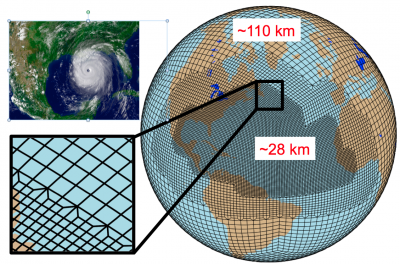Variable-Resolution Modeling Zooms into Atlantic Hurricane Seasons at Reduced Computational Costs
High-resolution climate modeling can reveal new insights into the many multi-scale interactions in the climate system. At grid resolution around 30 km and finer, meso-scale phenomena like tropical cyclones (TCs) start to become resolved and their climatology can be investigated in global GCMs. This provides an in-depth look at the model skill at fine resolutions and potential deficiencies in the physical parameterization packages. However, high-resolution climate modeling is costly from a computational viewpoint, and so far only very few global modeling studies with grid spacings of 30 km and below have been conducted. Therefore, we promote the use of variable-resolution (VR) grids that lower the computational demand while providing high-resolution regional climate information over areas of interests.
In the publication entitled ‘A multidecadal simulation of Atlantic tropical cyclones using a variable-resolution global atmospheric general circulation model’ two scientists from the University of Michigan (Colin Zarzycki, Christiane Jablonowski) demonstrate that the regionally-refined Community Atmosphere Model (CAM version 5) with its Spectral Element (SE) dynamical core reproduces many of the Atlantic hurricane statistics. In particular, they zoomed into the North Atlantic Ocean basin with a 0.25 degree (28 km) mesh which was embedded within a 1 degree (111 km) global grid. Two 23-year simulations with prescribed sea surface temperatures and sea ice were conducted (with and without the refined nest) in order to investigate the hurricane climatologies and the impact of the enhanced resolution on TCs.
The variable-resolution simulation produces significantly more TCs than the unrefined simulation. Storms that do form in the refined nest are much more intense, with multiple storms strengthening to Saffir-Simpson category 3 intensity or higher. Both count and spatial distribution of TC genesis and tracks in the variable-resolution simulation are well matched to observations and represent significant improvements over the unrefined simulation. Some degree of interannual skill is noted, with the variable-resolution grid able to reproduce the observed connection between Atlantic TCs and the El Nino Southern Oscillation (ENSO). It is shown that Genesis Potential Index (GPI) is well matched between the refined and unrefined simulations, implying that the introduction of variable-resolution does not affect the synoptic environment. Potential ‘upscale’ effects are noted in the variable-resolution simulation, suggesting stronger TCs in refined nests may play a role in meridional transport of momentum, heat, and moisture. The results demonstrate the variable-resolution modeling with CAM-SE is a skillful, mature technique for tropical cyclone studies and regional climate modeling in general.
This research was supported by the DoE Office of Science Awards DE-SC0003990 and DE-SC0006684. The authors thank Mark Taylor (Sandia National Laboratories) for his assistance with running CAM-SE, Peter Lauritzen (NCAR) for his help with generating variable-resolution topography data sets, and Michael F. Wehner (Lawrence Berkeley National Laboratory) for providing code which became the base for the cyclone tracking algorithm as well as fruitful discussions regarding high-resolution CAM simulations. Some of this work was completed while Colin Zarzycki was an invited attendee of the ‘Multiscale Numerics for the Atmosphere and Ocean’ programme at the Isaac Newton Institute for Mathematical Sciences in Cambridge, United Kingdom. The majority of the high performance computing support for this project was provided by NCAR’s Computational and Information Systems Laboratory which is sponsored by the National Science Foundation. The authors thank Paul Ullrich (University of California, Davis) for providing access to computing resources to complete supporting portions of this work.

